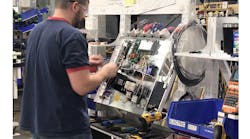Kevin Thompson made two videos last week and perhaps as many as 40 last year. They're short, typically 30 seconds to one-minute long and they showcase small improvements he has made to remove waste and improve his work environment.
His videos join a library of about 8,000 similarly themed videos created by the 140 employees of Cambridge Engineering Inc., a Chesterfield, Missouri-based company that designs and manufactures space heating, ventilation and cooling products for commercial and industrial facilities.
It's a company with a lean, continuous-improvement mindset, and the videos are one means by which to share employees' improvement ideas.
"We actually consider continuous improvement productive time," says Thompson. "It's a product that we're producing, so lean improvements are production for us. This is a very important element that many, many people miss with lean, I believe."
Thompson is passionate on the topic of lean and continuous improvement, but he's not Cambridge's continuous improvement leader. Or plant manager. Or a team leader on the shop floor. He's the chief financial officer.
Which is a very good thing for Cambridge. Read the literature or listen to anecdotes about successful lean implementations, and what consistently rises to the surface of the conversation is the need for the company to have a CFO who gets it. If the person behind the money is indifferent or even anti-lean, then lean manufacturing likely will never gain a foothold.
With finance's support, however, transformational change is possible.
Paul Haroldsen admits he is a manufacturing finance leader who did not get it, at least initially. Haroldsen is vice president of finance at Jotul North America. Based in Norway, Jotul manufactures cast iron fireplaces, wood stoves and gas stoves, and fireplace inserts. Its U.S. manufacturing operation is in Gorham, Maine.
Jotul North America's lean journey dates back some 18 years, prompted by a visit to the Jotul site by a vendor that was practicing lean manufacturing. That vendor pointed out an inventory reduction opportunity to Jotul's then manufacturing manager and invited him to visit the vendor site. The manager returned from the vendor visit "all energized and ready to go," remembers Haroldsen.
Knocking Heads
The vice president of finance did not share the same fervor. "We knocked heads a lot in the beginning," he says.
"I didn't really understand what he was trying to tell me. He would talk about min max inventory levels and I would say, no we have that … He would talk about pull versus push, and I would say, 'we're doing that,'" he says. "I thought I understood, but I was a little naïve."
The year 2005 would be a turning point of sorts for Haroldsen. Jotul North America was set to move into a new building, where the manufacturing manager proposed radical changes to material handling and inventory storage. The new layout would move inventory closer to the operators and significantly reduce material handling needs. However, instead of a potential improvement, what Haroldsen foresaw was an inventory-control challenge.
In that same year, Haroldsen attended his first lean accounting conference, where he met speaker Jerry Solomon, whose 40-year manufacturing career encompasses roles both in operations and finance, including multiple CFO positions.
Solomon is a huge proponent of lean accounting to support a lean growth strategy. He preaches what he practiced, most recently as vice president of operations at MarquipWardUnited.
At its most basic, lean accounting proposes presenting financial information, such as profit-and-loss statements, in "plain English" that can be understood by the 98% of a manufacturing workforce who are not accountants.
"That's all about respect for people," a leading tenet of lean, notes Solomon.
More than that, however, lean accounting methods are designed to support lean production operations and good decision-making in a way that traditional accounting simply cannot. For example, traditional accounting methods reward the build-up of inventory, which is the antithesis of lean's war on waste. So even as lean takes aim at excess inventory—and frees up cash—it negatively impacts the P&L in the short term.
"There is a big education that has to go on with the CFO in terms of understanding [lean] and how it is going to change the numbers," Solomon notes. "We have to change the way we keep score."
The now-retired manufacturing leader is the author of several books on lean accounting, including Who's Counting? A Lean Accounting Business Novel. Jotul's Haroldsen read the book; it ultimately became one of several inputs that aided his development into a CFO that "gets" it.
Of course, it helped that he also began to see lean's benefits hit the company's bottom line as efficiencies improved. For example, material handling costs dropped, the number of transactions declined, and the days required for the month-end close decreased by 80%, with fewer people involved.
Moreover, Haroldsen's frequent attendance at the company's morning "huddle" on the manufacturing floor has sharpened the accuracy of his forecasts to the corporate office. During that daily meeting, representatives from several departments review the previous day's activities and discuss ongoing challenges.
"I learn so much by being out there," he says. "I hardly ever give a surprise to our corporate office in Norway on the financials because I have my pulse on what's going on."
People Leader First, CFO Second
Over at Cambridge Engineering, the company embraces what Thompson describes as a subculture within the lean community called "2 Second Lean." It's a concept developed by Paul Akers, founder of FastCap, a company that produces woodworking products and tools, and author of 2 Second Lean: How to Grow People and Build a Fun Lean Culture at Work & at Home.
At Cambridge, 2 Second Lean translates to "trying to be a continuous improvement culture where people learn to see waste and hate it, and then have a passion for fixing it," Thompson explains. The focus is not on big teams or big projects, but individual empowerment to fix waste in the space the individual controls.
Cambridge Engineering does not talk about lean as a financial exercise, meaning as a method to save money. Instead, the company's lean focus is on growing people.
"What we believe, in a larger context, is that if as an organization we focus on culture, organizational health, reinforcing our values and growing our people to be the best they can be … there will naturally be financial consequences to all of this effort we are making," Thompson explains. "There will be a natural saving of money."
Not to mention the potential for growth. From a revenue perspective, Cambridge has nearly doubled in size over the past five years, without having to double the number of employees.
Further, Thompson is on the front lines of growing Cambridge Engineering's people. "I'm actually called to be a people leader first and a CFO second. My CFO role is obviously very important, and I do all the things normal CFOs do, but much of my job is culture building and organizational health building," he says.
Jotul North America, too, has reaped the benefits of lean, bolstered by a CFO who gets lean. In 2015 the company added wood stove assembly at its Maine plant, and soon it will be adding another 10 jobs.
"Lean has made us more efficient," Haroldsen says. "We did so well in inventory (reduction), we had room to double production in the same building."





